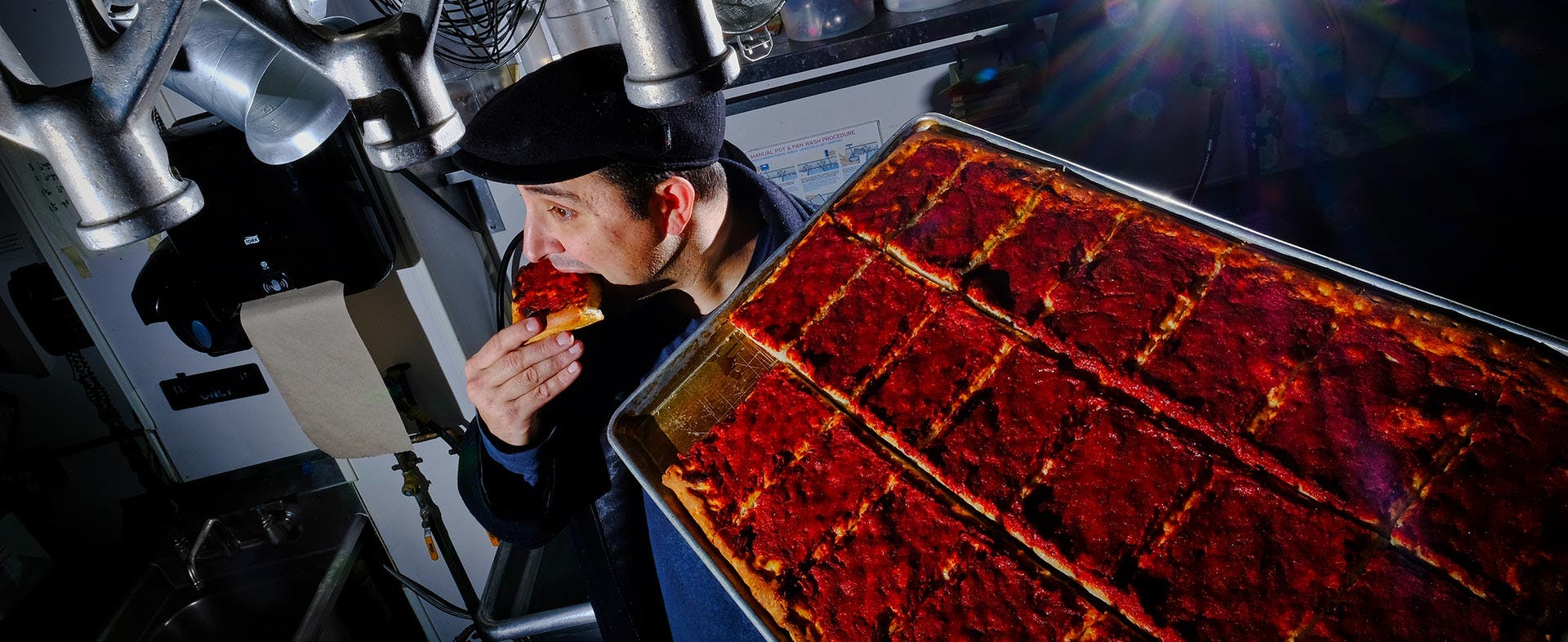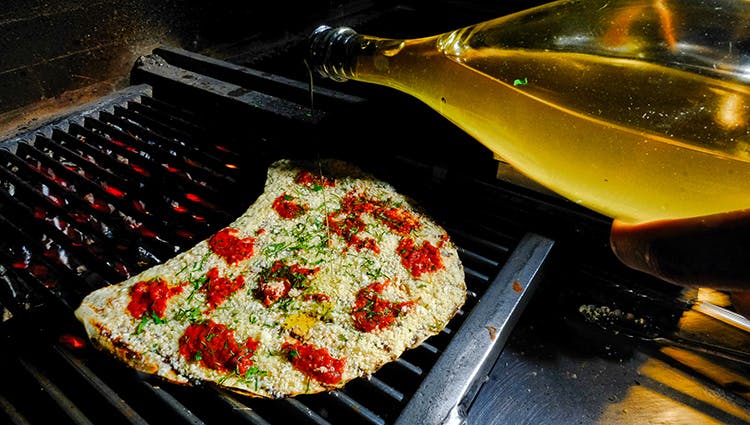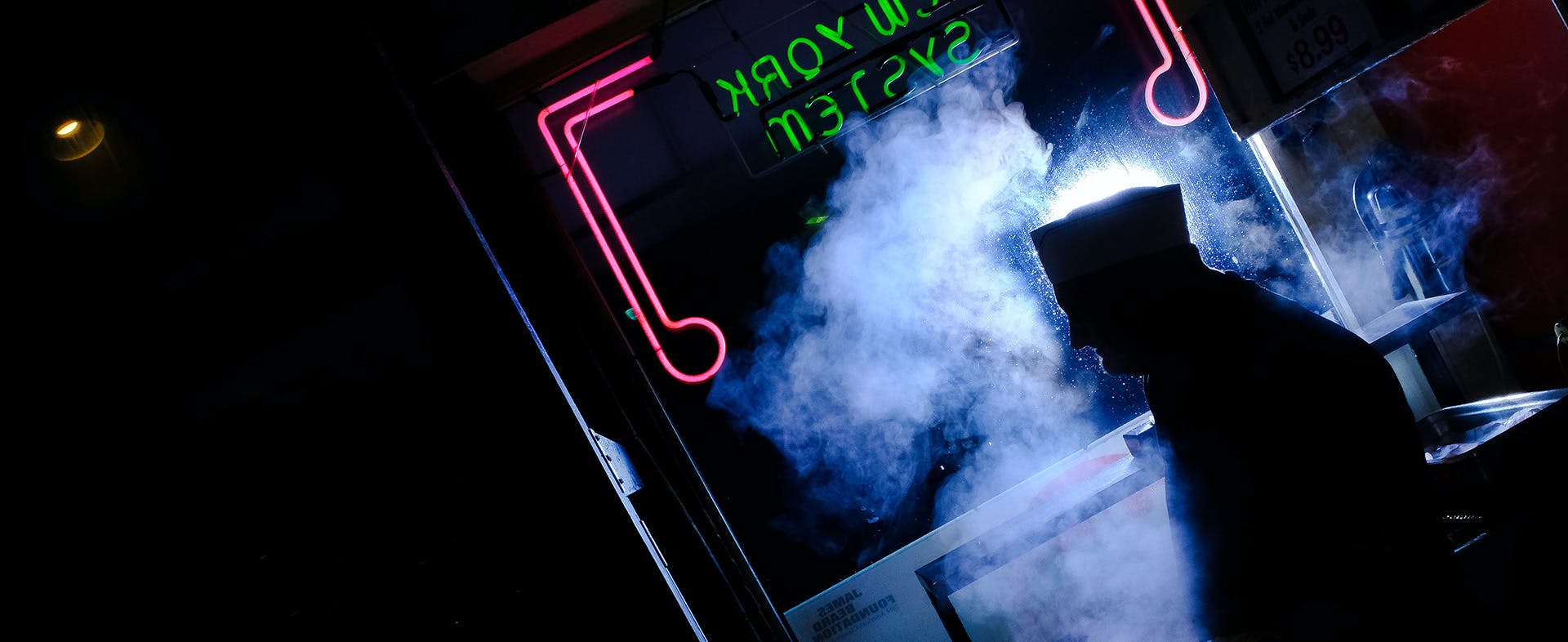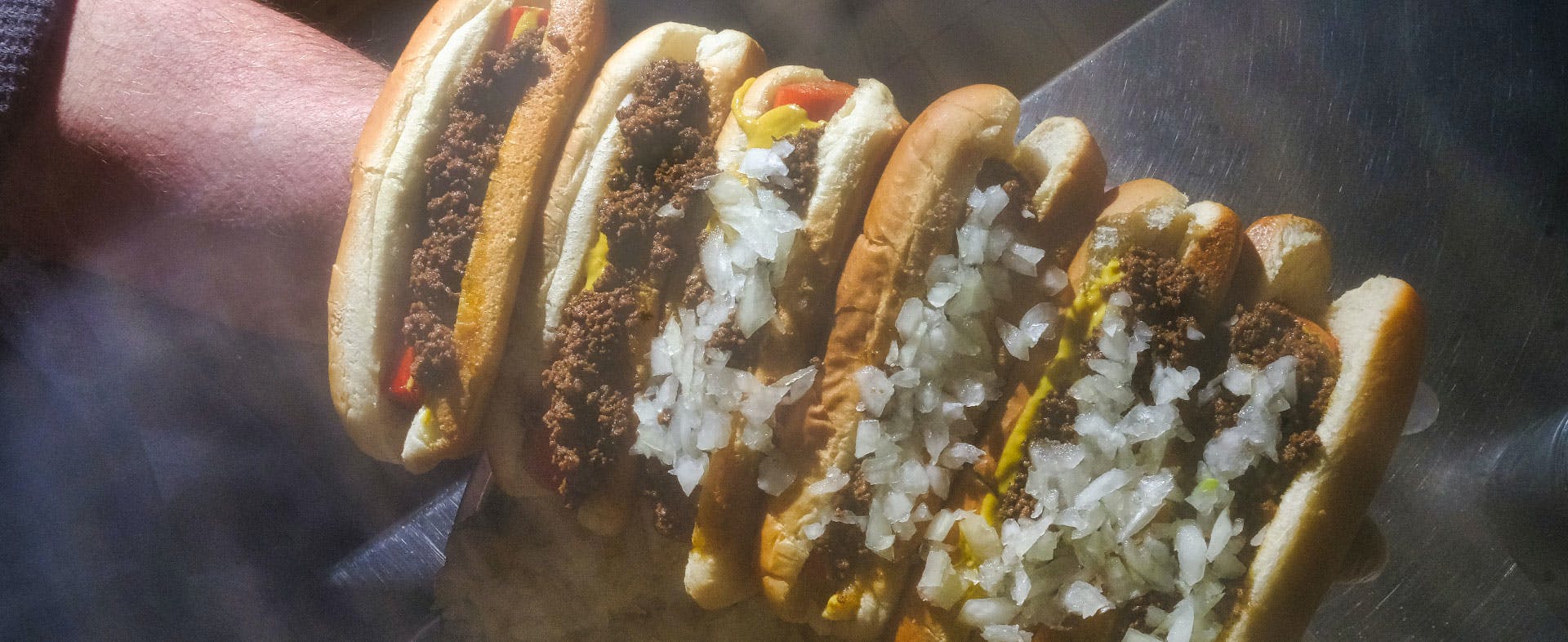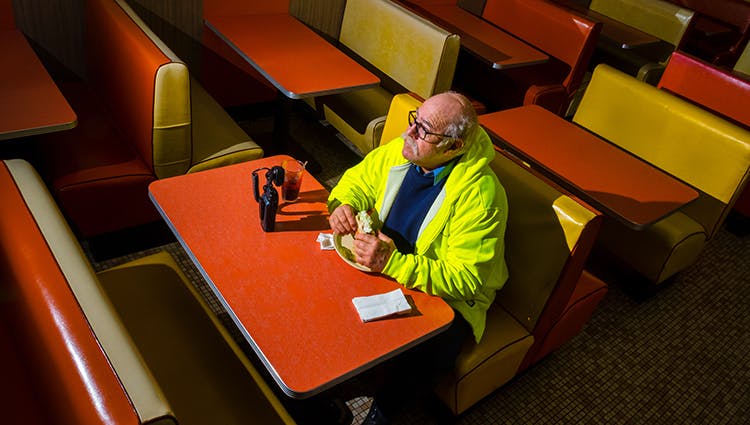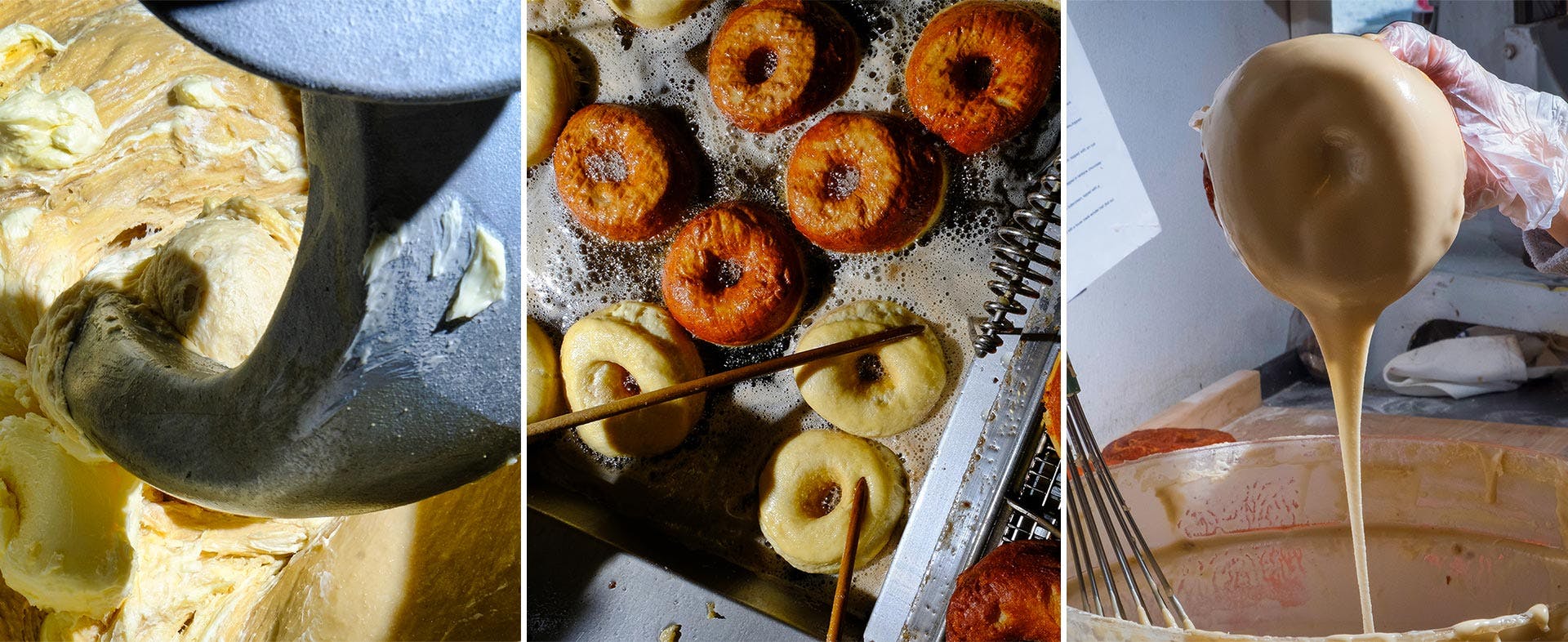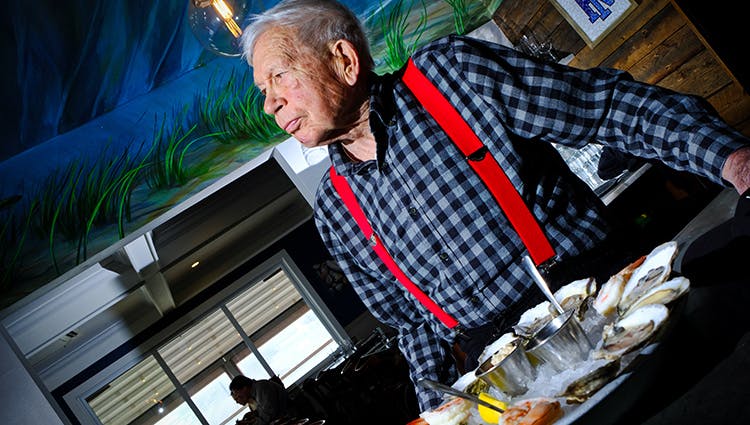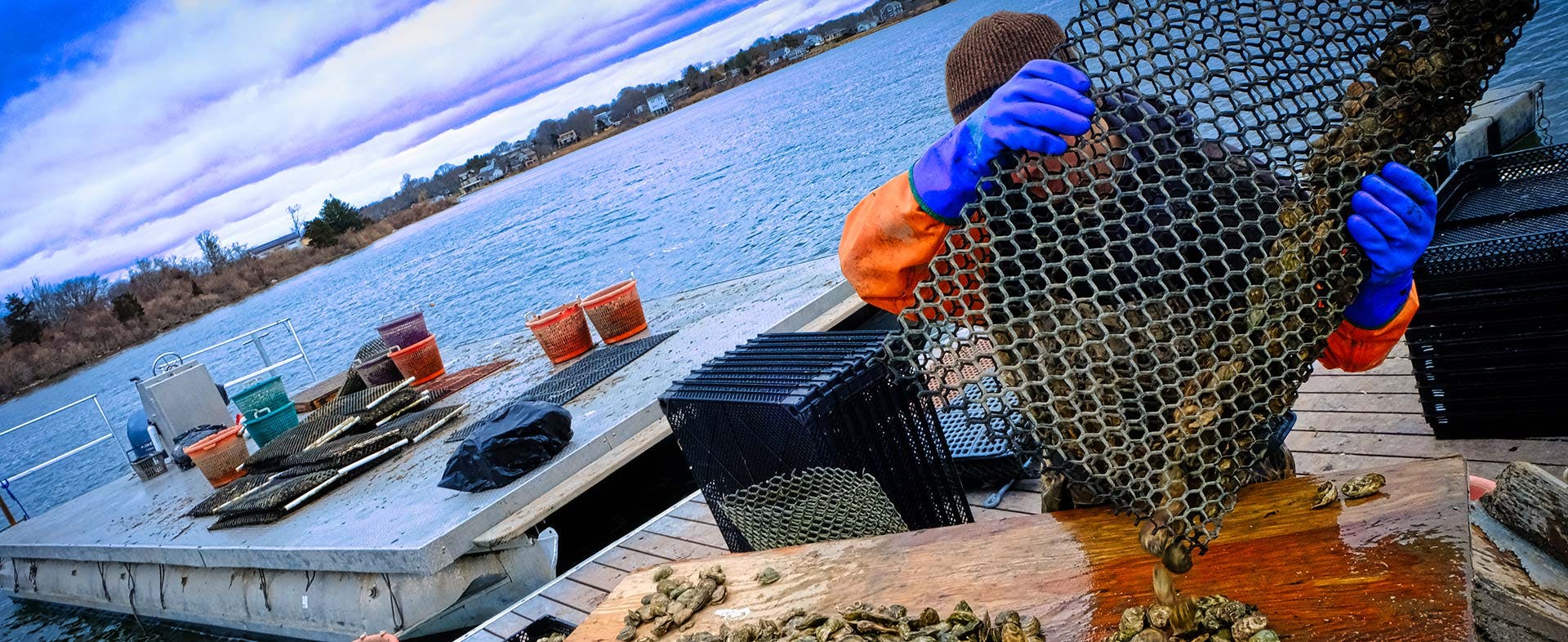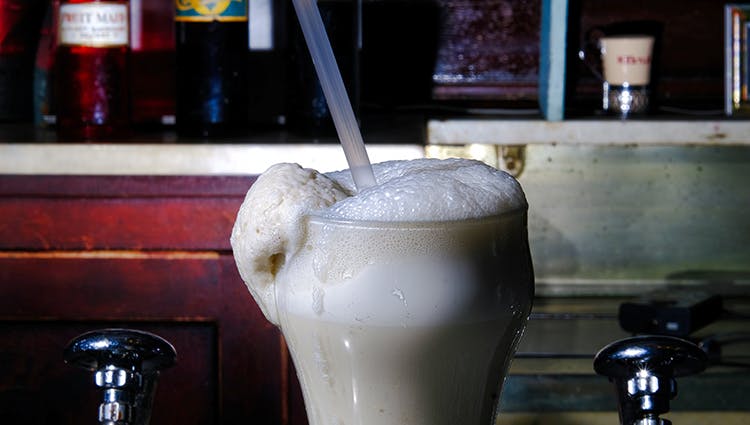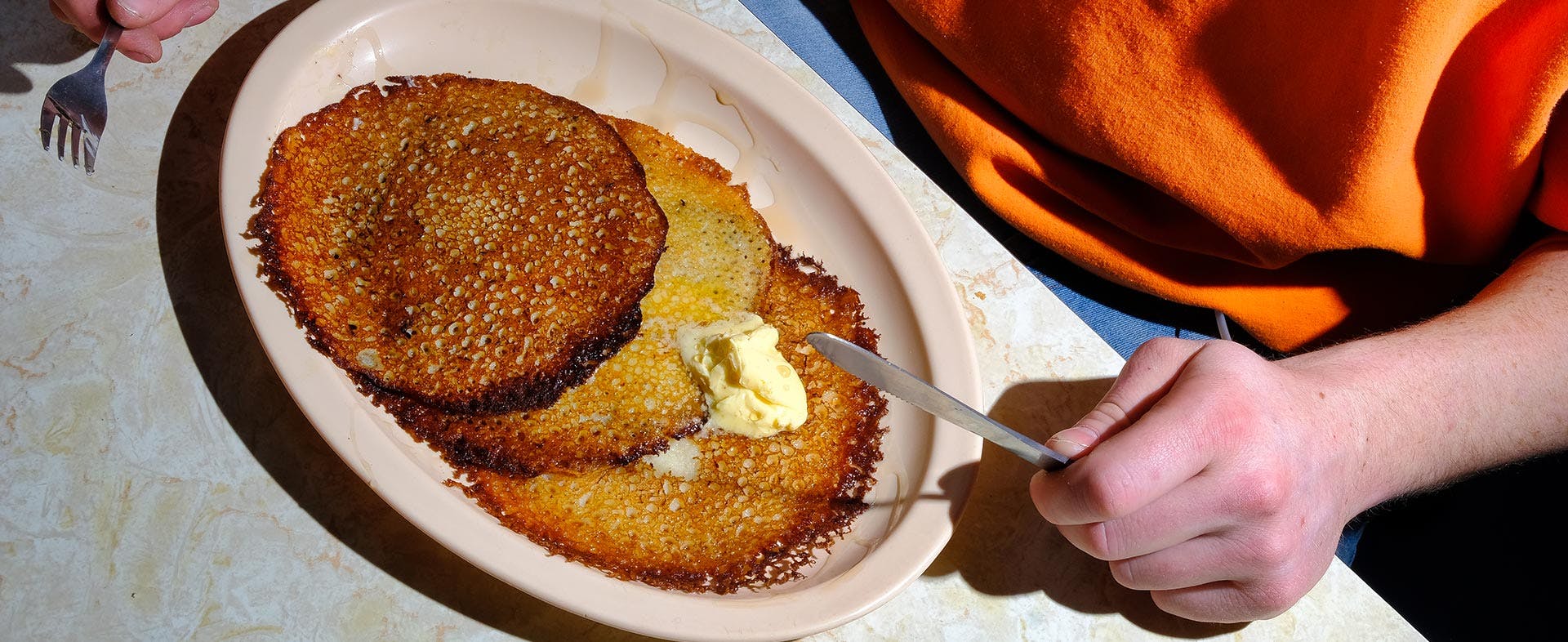“For the best restaurants in Boston, you have to head to Providence," my train mate said, giving me a look of derisive joy.
I'd mentioned I was on my way to Rhode Island to eat and explore, and his response was encouraging. The state—the smallest in the country—has a quirky chip on its shoulder, unsurprising for a place that's called an island but actually isn't one. Sandwiched between Connecticut and Massachusetts along a craggy coast, its inhabitants have developed an idiomatic state menu—full of such woolly ciphers as stuffies and cabinets. I was about to unpack its enigmatic wonders. First stop: secret pizza.
"No way. You can't get this pizza in a pizzeria," Michael Manni, the owner of LaSalle Bakery, said quixotically. I was tipped off by a local friend to the bakery's pizza strips (Rhode Island-ese for slices). But Manni was nonplussed. "I think you're missing the boat on this one, but you're the reporter," he said, lips pursed. The pizza strips—sitting in the back, un-merchandised—were an unsung RI staple, a crowd favorite baked in obscurity. He went on to tell me how close-knit things are here. "I opened up a second bakery three blocks from my other one, and everyone thanked me for moving into their neighborhood," he said laughing. "Now I'm going to open a third store, because I don't have enough problems."
Gleaming red under a luster of olive oil, the strip had no cheese and was meant to be eaten cold. (No, really. They won't heat it up for you.) "We call it bakery pizza. It's not made from pizza dough—we use the same dough as our bread," Manni said. Is it a Sicilian? A grandma slice? "Dunno. It's just the way we do it here."
Not content having created just one alternate pizza universe, Rhode Islanders created two. At Al Forno, you'll find grilled pizza. I know what you're thinking: That's like saying they invented salt on a pretzel. But it's true—they were first. As a part-time backyard grilled pizza duffer, I've wanted to come here for longer than 20 years to try the real thing.
I asked Phil Niosi, the sous-chef, what he thought of bakery pizza. "Oh, you mean party pizza," he said. "Um, I guess you have to be from Rhode Island," he said with a laugh and a politician's air, as if attempting to skirt a statewide pizza controversy. "In comparison, our pizza—as George, our founder, would say—is ethereal."
The nerve center of the kitchen was a grill enclosed by brick, turning it into an oven-grill hybrid. The cooks slung thin spheres of dough onto the grill grates to order, in a fashion not unlike a frantic Napoli pizzaiolo. Flipped and charred, the pizzas were sauced and topped in a matter of seconds. The result was a crisp yet chewy pie that was never round—sometimes shaped like a mezzaluna, sometimes like more of a Smurf's hat, a kind of pizza Rorschach test.
"I hate to use catchphrases, but it's all about balance," Niosi said. "Dot with sauce—a little bit here, a little bit there; each bite is just right—you can't weigh it down." I opted for a pie covered in spicy arrabbiata sauce and piled high with fried calamari. It came to the table uncut and shaped improbably like Rhode Island itself; I wasn't sure how to begin. The waiter mentioned that the strangest way he'd seen anyone eat it was to tear it up with their hands. So I chose that.
"They still do them up the arm there," my driver said as we approached my next stop. "Some have closed; they can't compete with this place. That's history. Three all the way with the coffee milk special." I didn't have time to decode what he was saying before we pulled up to Olneyville New York System Hot Wieners, and I entered under a searingly beautiful neon sign to meet the fourth-generation owner, Greg Stevens. He comes from a long line of hardworking Greek diner and lunch counter owners; his father used to work all day, come home for dinner, and then return to work. "The secret to this place is to keep it the same," he said, waving his hand over museum-quality diner trinkets. "Which is not as easy as it seems."
But what exactly is a hot wiener, and what is the New York System? Over by the window, Stevens opened up a small compartment flush with steam to snag a vapor-softened bun, into which he bounced a bright-red wiener, known to more self-conscious folks as a hot dog. While twirling mustard off a long wooden stick, he said, "Ours is completely natural. Look at the label on most wieners—scary." A comfy layer of chili, reminiscent of the spiced-meat layer on Greek pastichio, was tucked in under a bed of chopped raw onions.
This is the New York System—a chili dog done in the century-old fashion of Coney Island—brought by Stevens's grandfather to Rhode Island. After the first one, he kept making them, placing one after the other on this arm in a not-so-delicate balancing act. "Guess how many times people have complained about the arm technique?" said Stevens, as he answered his own question: "Zilch." The wieners were finished with a dusting of celery salt, which without question is the most neglected item in the American spice cabinet. They order 200 pounds of it at a time. As I asked him about the makeup of his customers, he gently cut me off—"Who comes here? Everybody comes here! Factory workers; people on the road; cops; the fourth, fifth and sixth generations of families."
--
I woke up early the next morning, ready for more carbs, and found them at PVDonuts, the city's first specialty doughnut shop. "If you wanted a chocolate sea salt, you'd have to go to Portland," said Paul Kettelle, who owns the place with his wife, Lori. "If you wanted a maple bacon, you'd have to drive to Boston." They started to experiment in their home kitchen with a brioche dough. "Things blew out of proportion real quick," Kettelle said. "We would make 500 doughnuts and immediately sell out. People were getting so mad!"
They're now up to 2,000 doughnuts a day, centered around a 90s-themed speciality menu, which was sparked by a flurry of taste memories set off by a Bill Clinton-era kitchen playlist. The doughnuts were dunked in various crunchy, sweet relics of a Technicolor supermarket snack aisle, with one to trigger every type of lunch box nostalgia. One was topped with a tiny mountain of Rice Krispies Treats, another had a Keebler Rainbow Chips Deluxe crown and there was one for every candy that ever gave you a cavity. I went for the Wildberry Pop-Tart.
With regional foods, people tend to have opinions. Lots of them. But I wasn't expecting someone to boo the home team. "There's Manhattan, and then there's New England clam chowder: One has tomato and the other cream," my cab driver said. "I think we've got it wrong." I needed to get some Rhode Island chowder—quick—to clear things up.
I was able to do so at the waterside Matunuck Oyster Bar: with a side of stuffies, or stuffed clams. Owner Perry Raso brought them over with the confident sauntering attitude of a 1950s Brooklyn boxer. The chowder was bright; clear broth was a happy surprise—I never knew what was under that cloak of cream. The clams were like Thanksgiving stuffing in a shell. After polishing off a few, I felt like I was the stuffie. Matunuck was not simply a restaurant, but a functioning oyster farm—the vast expanse of water outside was also under his stewardship.
Raso, it turns out, was a reluctant restaurateur: "I bought this place originally to have a spot to dock my oyster boats. But the next thing you know . . ." The next thing I knew, Raso had on fisherman's waders, and we were speeding on a boat to see the oysters. Bobbing in the waters of Potter Pond were thousands of netted bags filled with millions of oysters, bathing in and filtering the local environment. Workers violently jumped on and off skiffs, dragging oysters aboard to be sorted by size into teetering, flinty piles.
After the oyster adventure, it was time for dessert. "Your milkshake is our cabinet, also called a frappé in Massachusetts. A milkshake is just milk and flavored syrup here." Eric Delekta, owner of the 100-year-old Delekta Pharmacy, was at once giving me a linguistics lesson and introducing me to a superior way to eat ice cream. Surrounded by the elixirs of an era when medicine and food worked hand in hand, I spied a mysterious red potion labeled Thrill. I didn't ask questions; I was just there for the cabinet.
All of the syrup pump buttons were brightly labeled with their contents, except one—the homemade coffee syrup—which was obliterated by constant use. Customer after customer traipsed in for a coffee cabinet (not to be confused with coffee milk): a burr and froth of coffee ice cream and syrup with icy-cold milk. I asked one regular, Ronny, how often he had one. "What'd figure, Eric? Five or six a week?" he asked. "It's top of the line here . . . and so is the charming company." Oh, and about the name—it turns out that the blender used was stored in a cabinet. Maybe. No one's really sure.
Last stop on my Rhode Island tour: johnnycakes (or corn cakes). They were sitting on a plate in front of me at Bishop's 4th Street Diner, and I was a bit startled. I was expecting plump corn bread-like slabs, but these put the flat in flat as a pancake. Once I got over that, I saw their true beauty. Wisps of crispness laced the outer edges of each cake as a monstrous dab of butter slouched on top. The cakes themselves had more holes than a sponge, so I decided to do the right thing and fill them with maple syrup.
"The recipe is a little bit of a secret," the owner, Nancy Reed, said. "But you have to crank up that griddle to get them this way—you can't get a pan that hot at home." But all those holes! There had to be an explanation. Was there a lot of baking powder? "Nope," Reed said, averting her eyes. "It's a just a Rhody thing."
